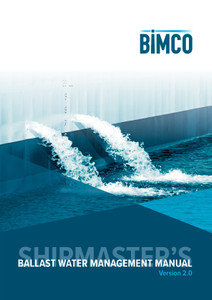
This publication provides practical information to Governments, particularly those of developing countries, Administrations, ship owners, port State control authorities, environmental agencies and other stakeholders on the implications of ratifying and enforcing the Ballast Water Management Convention.
This publication includes extensive guidance on implementing each regulation of the Ballast Water Management Convention, from general applicability to exceptions and exemptions. Consideration is also given to crew training and personnel administration. It should be noted that this is a reference document and, for legal purposes, the authentic text of the Convention should always be consulted.
Harmful aquatic organisms and pathogens present a major threat to marine ecosystems and shipping has been identified as a significant pathway for introducing species to new environments. The problem has increased with the introduction of steel hulls, allowing ships to use water instead of solid materials as ballast, and in particular over the last few decades as trade and traffic volumes have expanded. The effects of the introduction of non-indigenous species have, in many areas of the world, been devastating. Quantitative data show that the rate of bio-invasions is continuing to increase significantly. As the volumes of seaborne trade continue to increase, the problem may not yet have reached its peak.
The
Convention
aims
to
prevent,
minimise
and
ultimately
eliminate
risks
to
the
environment,
human
health,
property
and
resources
arising
from
the
transfer
of
harmful
aquatic
organisms
and
pathogens,
by
establishing
standards
and
procedures
for
the
management
and
control
of
ships’
ballast
water
and
sediments.
Under
the
Convention,
ships
to
which
the
Convention’s
provisions
apply
will
be
required
to
manage
their
ballast
water
and
sediments
to
a
certain
standard,
according
to
a
ship
specific
ballast
water
management
plan
(BWMP).
Ships
will
also
have
to
carry
a
ballast
water
record
book
(BWRB)
and
an
International
Ballast
Water
Management
Certificate
(IBWMC).
The
ballast
water
management
standards
will
be
phased
in
over
a
period
of
time.
Initially,
ships
subject
to
the
Convention’s
ballast
water
requirements
will
be
required
to
exchange
ballast
water
mid-ocean.
In
due
course
these
ships
are
required
to
meet
a
performance
standard
that
limits
the
number
of
organisms
in
discharged
ballast
water.
Parties
to
the
Convention
are
given
the
option
to
take
additional
measures,
which
are
subject
to
criteria
set
out
in
the
Convention
and
relevant
guidelines
for
its
uniform
implementation.
The
Convention
consists
of
articles
and
annexes
which
include
legal
requirements,
technical
standards
and
regulations
for
the
control
and
management
of
ships’
ballast
water
and
sediments.
There
are
also
various
resolutions
and
circulars
developed
by
the
Organization
relating
to
it.
Part 1 Rights and obligations
1.2 Structure and components of the Convention
1.3 Rights and obligations under the Convention
1.4 Jurisdiction
Part 2 Meeting obligations
2.1 Means of meeting obligations
Part 3 Legal aspects
3.1 Integrating the Convention in domestic law
3.2 Legal aspects of enforcement
Part 4 Implementing the regulations
4.1 Implementing Section A (general provisions)
4.2 Implementing Section B (management and control requirements for ships)
4.3 Implementing Section C (special requirements in certain areas)
4.4 Implementing Section D (standards for ballast water management)
4.5 Implementing Section E (survey and certification requirements for ballast water management)
4.6 Ballast water sampling
4.7 Approval of ballast water management systems (Guidelines (G8))
4.8 Approval of ballast water management systems using active substances (Procedure (G9))
4.9 Duties of ship owners
4.10 Ballast water management options available for ships
Part 5 Technical aspects of enforcement
5.1 Non-compliance detection and response
5.2 Guidance for port State control
Part 6 Organization
6.1 Training of personnel
6.2 Guidelines, circulars and other IMO instruments relevant to the Convention
As a specialized agency of the United Nations, IMO is the global standard setting authority for the safety, security and environmental performance of international shipping. Its main role is to create a regulatory framework for the shipping industry that is fair and effective, universally adopted and universally implemented.
In other words, its role is to create a level playing field so that ship operators cannot address their financial issues by simply cutting corners and compromising on safety, security and environmental performance. This approach also encourages innovation and efficiency.
Shipping is a truly international industry, and it can only operate effectively if the regulations and standards are themselves agreed, adopted and implemented on an international basis. And IMO is the forum at which this process takes place.
- Number of Pages:
- 106
- ISBN:
- 9789280116816
- Published Date:
- October 2017
- Book Height:
- 210 mm
- Book Width:
- 150 mm
- Author:
IMO
- Preview:
- Yes
- Binding Format:
- Paperback
- Publication Date:
- October 2017



